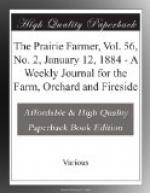* * * * *
On the grounds of the Pomological Institute, at Proskau, Silesia, we saw many varieties of the Amarelle and Spanish cherries that will bear more summer heat, an aridity of air, and a lower summer temperature than our Richmonds or English Morello. In leaf and habit of growth these Amarells of Austria and South Russia are much like our Carnalion, but some of the varieties bear large fruit, as nearly sweet as is desirable for dessert use. The race known as Spanish bears sweet fruit, much like our tall growing Hearts and Bigarreaus, but the leaves are smaller, firmer, and thicker, and the habit of the tree is nearly as low and spreading as that of the Amarells. In Austria we are told that the original stock of these round-topped, sweet cherries came from Spain, but as we went east to Orel, Veronish, and Saratov we met varieties of this race on the grounds of amateurs and proprietors who told us that the race was indigenous to Bokara and other parts of Central Asia. While these varieties are hardier than the Richmond the trees are lightly protected with straw during the winter for protection of the fruit buds, when paying crops are secured. North of Orel the Griottes alone are grown on the bush plan, with from three to six stems springing up from the crown. In Vladimir tens of thousands of acres are covered with these bush cherry orchards, producing many train loads annually of fruit of surprising excellence, considering the far northern and inland location of the plantations.
On the college farm we have some specimens growing of the Ostheim, Vladimir, double Natte, and other forms of the Griottes, and a few specimens from Orel and Veronish of the Amarells and the Spanish races. We have now orders out, of which we have received a part, for perhaps fifty other varieties from Austria, Poland, and South Russia.
For the present these will be planted in experimental orchard with a view to noting their behavior in our climate. Until scions are grown here we can not make much advance in propagation. The work is necessarily slow, but it can not fail, I think, to finally demonstrate that so far we have been on the wrong track in attempting to grow cherries on the prairies of the Northwest.
PRUNINGS.
If turnips or other vegetables to be fed to stock become frosted, place them in a cool cellar, cover lightly with straw, and let them remain frozen. If they do not thaw they will be little harmed for feeding.
Snow should not be allowed to accumulate on evergreens. If so, and it partly thaws and then freezes, it can not be removed, but will catch the snow and wind, often to the entire destruction of the tree.
A frost proof vegetable house is described as made with walls fifteen inches thick, double boarded, the space between the boards being filled with sawdust. The ceiling is also boarded, with about ten inches of sawdust between the boards.




